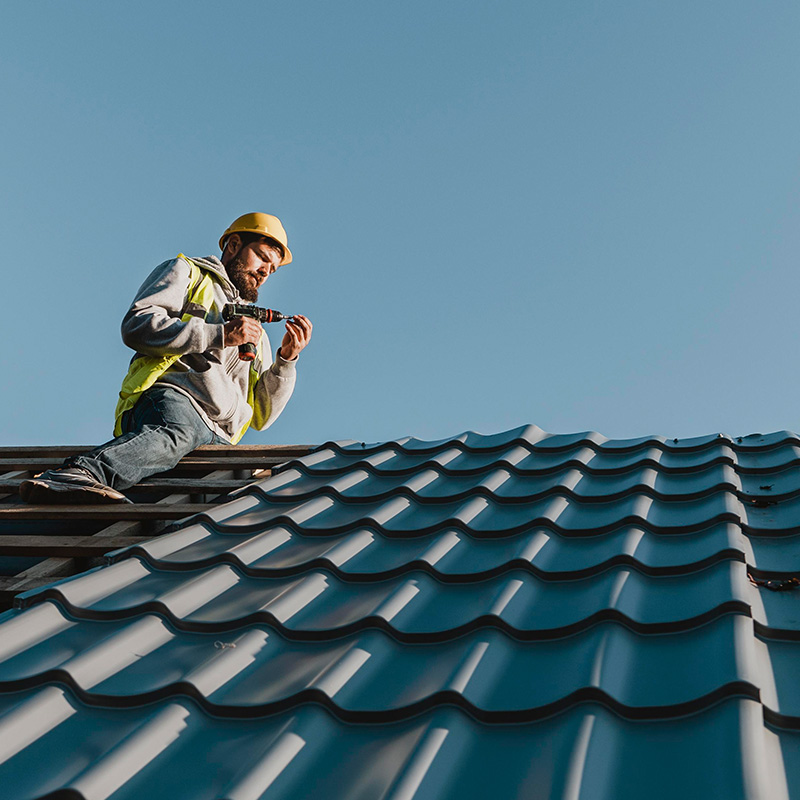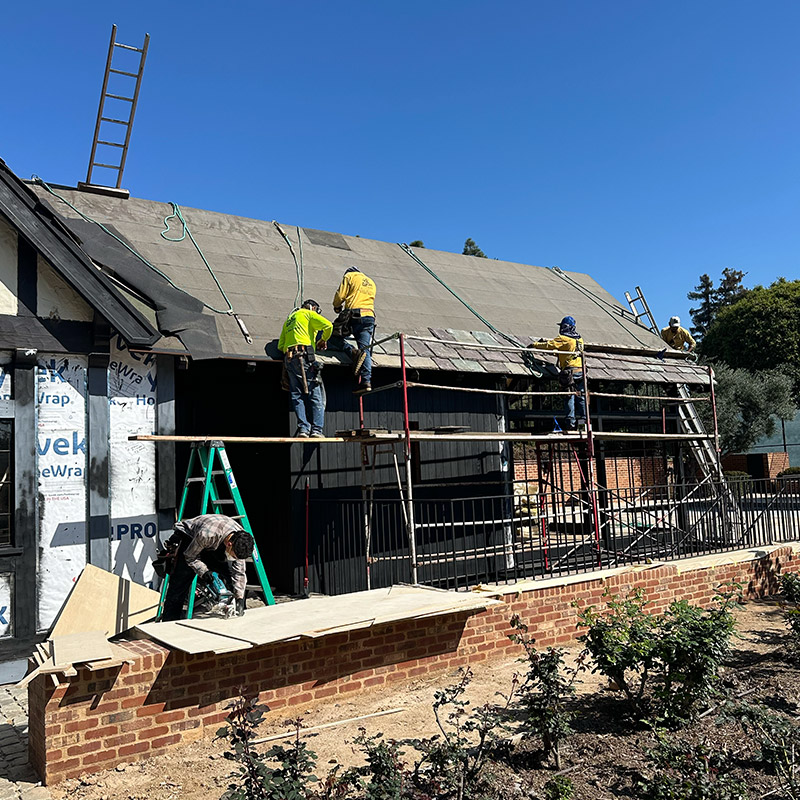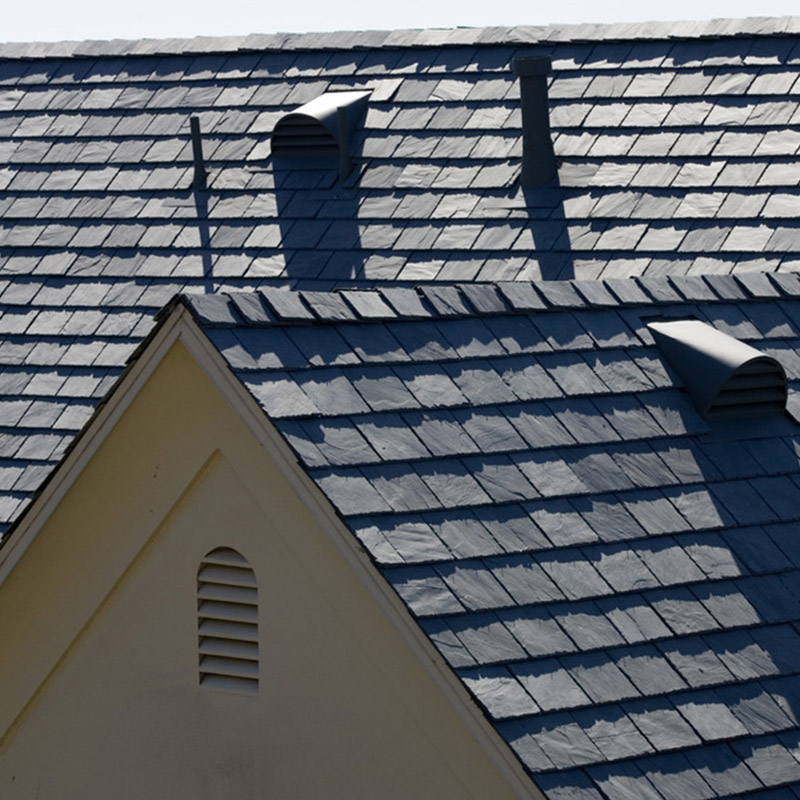There are a number of things to consider when selecting a new roof system. Of course, cost and durability head the list, but aesthetics and architectural style are important, too. The right roof system for your home or building is one that balances the following five items.
All steep-slope roof systems (i.e., roofs with slopes of 25 percent or more) have five basic components:
- Roof covering: shingles, tile, slate or metal, and underlayment that protect the sheathing from weather.
- Sheathing: boards or sheet material that are fastened to roof rafters to cover a house or building.
- Roof structure: rafters and trusses constructed to support the sheathing.
- Flashing: sheet metal or other material installed into a roof system’s various joints and valleys to prevent water seepage.
- Drainage: a roof system’s design features, such as shape, slope, and layout that affect its ability to shed water.
The following roofing products commonly are used for steep-slope structures.
Asphalt shingles possess an overwhelming share of the U.S. steep-slope roofing market and can be reinforced with organic or fiberglass materials. Although asphalt shingles reinforced with organic felts have been around much longer, fiberglass-reinforced products now dominate the market.
- Organic shingles: consist of a cellulose-fiber (i.e., wood) base that is saturated with asphalt and coated with colored mineral granules.
- Fiberglass shingles: consist of a fiberglass mat, top-and-bottom layers of asphalt, and mineral granules.
Asphalt shingles’ fire resistances, like most other roofing materials, are categorized by Class A, B, or C. Class A signifies the most fire-resistant; Classes B and C denote less fire resistance. Generally, most fiberglass shingles have Class A fire ratings, and most organic shingles have Class C ratings.
A shingle’s reinforcement has little effect on its appearance. Organic and fiberglass products are available in laminated (architectural) grades that offer a textured appearance. Zinc or copper-coated ceramic granules also can be applied to organic or fiberglass products to protect against algae attack, a common problem in warm, humid parts of the United States. Both types of shingles also are available in a variety of colors.
Regardless of their reinforcing type and appearance, asphalt shingles’ physical characteristics vary significantly. When installing asphalt shingles, the National Roofing Contractors Association (NRCA) recommends use of shingles that comply with American Society for Testing and Materials (ASTM) standards — ASTM D 225 for organic shingles and ASTM D 3462 for fiberglass shingles. These standards govern the composition and physical properties of asphalt shingles; not all asphalt shingles on the market comply with these standards. If a shingle product complies with one of these standards, it is typically noted in the manufacturer’s product literature and on the package wrapper.
Wood shingles and shakes are made from cedar, redwood, southern pine, and other woods; their natural look is popular in California, the Northwest, and parts of the Midwest. Wood shingles are machine-sawn; shakes are handmade and rougher looking. A point to consider: some local building codes limit the use of wood shingles and shakes because of concerns about fire resistance. Many wood shingles and shakes only have Class C fire ratings or no ratings at all. However, Class A fire ratings are available for certain wood shingle products that incorporate a factory-applied, fire-resistant treatment.
Tile clay or concrete is a durable roofing material. Mission and Spanish-style round-topped tiles are used widely in the Southwest and Florida, and flat styles also are available to create French and English looks. Tile is available in a variety of colors and finishes. Tile is heavy. If you are replacing another type of roof system with tile, you will need to verify that the structure can support the load.
Slate is quarried in the United States in Vermont, New York, Pennsylvania, and Virginia. It is available in different colors and grades, depending on its origin. Considered virtually indestructible, it is, however, more expensive than other roofing materials. In addition, its application requires special skill and experience. Many old homes, especially in the Northeast, still are protected by this long-lasting roofing material.
Metal, primarily thought of as a low-slope roofing material, has been found to be a roofing alternative for home and building owners with steep-slope roofs. There are two types of metal roofing products: panels and shingles. Numerous metal panel shapes and configurations exist. Metal shingles typically are intended to simulate traditional roof coverings, such as wood shakes, shingles, and tile. Apart from metal roofing’s longevity, metal shingles are relatively lightweight, have a greater resistance to adverse weather, and can be aesthetically pleasing. Some have Class A fire ratings.
Synthetic roofing products simulate various traditional roof coverings, such as slate and wood shingles and shakes. However, they do not necessarily have the same properties.
Before making a buying decision, NRCA recommends that you look at full-size samples of a proposed product, as well as manufacturers’ brochures. It also is a good idea to visit a building that is roofed with a particular product.
Click here to read other articles included in our Roof Buying Guide series.



